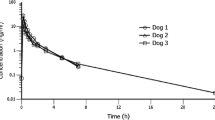Summary
Penetration into lumbar cerebrospinal fluid (CSF) of lidocaine and its active desethylated metabolite, monoethylglycinxylidide (MEGX), has been studied in 10 neurological patients after a single subcutaneous injection of 2 mg/kg prior to lumbar puncture. An HPLC method was used to assay lidocaine, MEGX and glycinxylidide (GX) in serum and CSF. The serum protein unbound fraction of lidocaine was determined by equilibrium dialysis. The mean peak serum lidocaine concentration was found 25 minutes after injection, and the corresponding peak CSF level occurred after 70 min. A similar slow penetration of MEGX into CSF was observed, which indicates low membrane permeability for these two agents. No GX was found. The steadily increasing CSF lidocaine/serum total lidocaine ratio throughout the period of study up to 120 min and the higher level in CSF than the corresponding unbound fraction of the total serum lidocaine indicate that serum protein binding is not the sole determinant of the penetration of lidocaine into lumbar CSF. Rapid accumulation in brain tissue and diffusion back into cerebral extracellular fluid and to lumbar CSF may also occur. The apparent slow membrane penetration of lidocaine and its desethylated metabolite may be one reason for the difficulty of controlling lidocaine infusion rates according to therapeutic effectiveness and side-effects.
Similar content being viewed by others
References
Bonati M, Kanto J, Tognoni G (1982) Clinical pharmacokinetics of cerebrospinal fluid. Clin Pharmacokinet 7: 312–335
Bernhard CG, Bohm E (1954) On the effects of xylocaine on the central nervous system with special references to its influence on epileptic phenomena. Experientia 10: 474–476
Taverner D, Bain WA (1958) Intravenous lignocaine as an anticonvulsant in status epilepticus and serial epilepsy. Lancet 29: 1145–1147
Crampton RS, Oriscello RG (1968) Petit and grand mal convulsions during lidocaine hydrochloride treatment of ventricular tachycardia. J Am Med Assoc 204: 201
Julien RM (1973) Lidocaine in experimental epilepsy: Correlation of anticonvulsant effect with blood concentrations. Electroencephalogr Clin Neurophysiol 34: 639–645
Usubiaga JE, Moya F, Wikinski JA, Wikinski R, Usubiaga LE (1967) Relationship between the passage of local anaesthetics across the blood-brain barrier and their effects on the central nervous system. Br J Anaesth 39: 943–946
Spector R (1980) Transport of lignocaine by rabbit choroid plexus in vitro. Clin Sci 58: 107–109
Narang PK, Grouthamel WG, Carliner NH, Fisher M (1978) Lidocaine and its active metabolites. Clin Pharmacol Ther 24: 654–662
Reger PS, Benowitz NL, Bronstein J, Jacop P (1982) Increased brain uptake of lidocaine during bicuculline-induced status epilepticus in rats. 32: 196–199
Harrison DC, Alderman EL (1972) The pharmacology and clinical use of lidocaine as an antiarrhythmic. Mod Treatment 9 [1]: 139–175
Rydèn L, Waldenström A, Ginses Y, Örtengren B (1975) Blood levels of lidocaine after various rates in patients with acute myocardial infarction. Am Heart J 89: 470–473
Author information
Authors and Affiliations
Rights and permissions
About this article
Cite this article
Laurikainen, E., Marttila, R., Lindberg, R. et al. Penetration of lidocaine and its active desethylated metabolite into cerebrospinal fluid in man. Eur J Clin Pharmacol 25, 639–641 (1983). https://doi.org/10.1007/BF00542352
Received:
Revised:
Accepted:
Issue Date:
DOI: https://doi.org/10.1007/BF00542352



